ABSTRAL
-
fentanyl citrate tablet
ProStrakan, Inc.
----------
|
||||||||||||||||||||||
FULL PRESCRIBING INFORMATION
WARNINGS: POTENTIAL FOR ABUSE and IMPORTANCE OF PROPER PATIENT SELECTION
ABSTRAL contains fentanyl, an opioid agonist and a Schedule II controlled substance, with an abuse liability similar to other opioid analgesics. ABSTRAL can be abused in a manner similar to other opioid agonists, legal or illicit. Consider the potential for abuse when prescribing or dispensing ABSTRAL in situations where the physician or pharmacist is concerned about an increased risk of misuse, abuse or diversion. Schedule II opioid substances which include morphine, oxycodone, hydromorphone, oxymorphone, and methadone have the highest potential for abuse and risk of fatal overdose due to respiratory depression.
Serious adverse events, including deaths, in patients treated with other oral transmucosal fentanyl products have been reported. Deaths occurred as a result of improper patient selection (e.g., use in opioid non-tolerant patients) and/or improper dosing. The substitution of ABSTRAL for any other fentanyl product may result in fatal overdose.
ABSTRAL is indicated only for the management of breakthrough pain in cancer patients 18 years of age and older who are already receiving and who are tolerant to opioid therapy for their underlying persistent cancer pain. Patients considered opioid tolerant are those who are taking at least 60 mg of oral morphine/daily, or at least 25 mcg transdermal fentanyl/hour, or at least 30 mg of oral oxycodone daily, or at least 8 mg oral hydromorphone daily, at least 25 mg oral oxymorphone daily or an equianalgesic dose of another opioid for a week or longer.
ABSTRAL is contraindicated in opioid non-tolerant patients and is contraindicated in the management of acute or postoperative pain, including headache/migraine, dental pain, or use in the emergency room. Life-threatening respiratory depression could occur at any dose in opioid non-tolerant patients. Deaths have occurred in opioid non-tolerant patients treated with other fentanyl products.
When prescribing, do not convert patients on a mcg per mcg basis from another fentanyl product to ABSTRAL. Patients beginning treatment with ABSTRAL must begin with titration from the 100 mcg dose [See Dosage and Administration (2.1)].
When dispensing, do not substitute an ABSTRAL prescription for other fentanyl products. Differences exist in the pharmacokinetics of ABSTRAL compared to other fentanyl products that could result in clinically important differences in the amount of fentanyl absorbed and could result in fatal overdose.
Special care must be used when dosing ABSTRAL. If the breakthrough pain episode is not relieved patients must wait at least 2 hours before treating another episode of breakthrough pain with ABSTRAL [See Dosage and Administration (2.1)].
ABSTRAL is intended to be used only in the care of opioid tolerant cancer patients and only by healthcare professionals who are knowledgeable of, and skilled in, the use of Schedule II opioids to treat cancer pain.
Patients and their caregivers must be instructed that ABSTRAL contains a medicine in an amount which can be fatal in children, in individuals for whom it is not prescribed, and in those who are not opioid tolerant. All packs must be kept out of the reach of children [see Patient Counseling Information (17.1), Contraindications (4) and How Supplied/Storage and Handling (16.3)].
The concomitant use of ABSTRAL with cytochrome P450 3A4 inhibitors may result in an increase in fentanyl plasma concentrations, and may cause potentially fatal respiratory depression [see Drug Interactions (7)].
Because of the risk for misuse, abuse, addiction, and overdose, ABSTRAL is available only through a restricted program, required by the Food and Drug Administration, called the ABSTRAL REMS (Risk Evaluation and Mitigation Strategy). Under the ABSTRAL REMS, healthcare professionals who prescribe to outpatients, outpatients, pharmacies and distributors must enroll in the program to prescribe, receive, dispense, and distribute ABSTRAL, respectively. [see Warnings and Precautions (5.10)]. Further information is available at www.abstralrems.com or by calling 1-888-227-8725.
1 INDICATIONS AND USAGE
ABSTRAL (fentanyl) sublingual tablets are indicated only for the management of breakthrough pain in cancer patients 18 years of age and older who are already receiving, and who are tolerant to, opioid therapy for their underlying persistent cancer pain. Patients considered opioid tolerant are those who are taking around-the-clock medicine consisting of at least 60 mg of oral morphine daily, or at least 25 mcg of transdermal fentanyl/hour, or at least 30 mg of oral oxycodone daily, or at least 8 mg of oral hydromorphone daily or at least 25 mg oral oxymorphone daily, or an equianalgesic dose of another opioid medication daily for a week or longer.
ABSTRAL is contraindicated for patients who are not already tolerant to opioids because life-threatening respiratory depression and death could result at any dose in patients not on a chronic regimen of opioids. For this reason, ABSTRAL is contraindicated in the management of acute or postoperative pain, including headache/migraine, dental pain, or use in the emergency room.
ABSTRAL is intended to be prescribed only by healthcare professionals who are knowledgeable of, and skilled in, the use of Schedule II opioids to treat cancer pain, and to be supplied only through the ABSTRAL REMS program [see Warnings and Precautions (5.10)].
2 DOSAGE AND ADMINISTRATION
As with all opioids, the safety of patients using such products is dependent on health care professionals prescribing them in strict conformity with their approved labeling with respect to patient selection, dosing, and proper conditions for use. Healthcare professionals who prescribe ABSTRAL for outpatient use, must enroll in the ABSTRAL REMS program [See Warnings and Precautions (5.10)].
2.1 Dose Titration
The objective of dose titration is to identify an effective and tolerable maintenance dose for ongoing management of breakthrough cancer pain episodes. The effective and tolerable dose of ABSTRAL will be determined by dose titration in individual patients.
Carefully supervise patients until a dose that provides adequate analgesia with tolerable side effects is reached for breakthrough pain control.
Starting Dose: Individually titrate ABSTRAL to a dose that provides adequate analgesia with tolerable side effects. Begin titration of all patients with an initial dose of ABSTRAL of 100 mcg. Due to differences in the pharmacokinetic properties and individual variability, even patients switching from other fentanyl containing products to ABSTRAL must start with the 100 mcg dose. ABSTRAL is not equivalent on a mcg per mcg basis with all other fentanyl products, therefore, do not switch patients on a mcg per mcg basis from any other fentanyl product. ABSTRAL is NOT a generic version of any other fentanyl product.
Start all patients with a single 100 mcg tablet.
- If adequate analgesia is obtained within 30 minutes of administration of the 100 mcg tablet, continue to treat subsequent episodes of breakthrough pain with this dose.
- If adequate analgesia is not obtained after ABSTRAL, the patient may use a second ABSTRAL dose (after 30 minutes) as directed by their health care provider. No more than two doses of ABSTRAL may be used to treat an episode of breakthrough pain.
- Patients must wait at least 2 hours before treating another episode of breakthrough pain with ABSTRAL.
Titration Steps: If adequate analgesia was not obtained with the first 100 mcg dose, continue dose escalation in a stepwise manner over consecutive breakthrough episodes until adequate analgesia with tolerable side effects is achieved. Increase the dose by 100 mcg multiples up to 400 mcg as needed. If adequate analgesia is not obtained with a 400 mcg dose, the next titration step is 600 mcg. If adequate analgesia is not obtained with a 600 mcg dose, the next titration step is 800 mcg. During titration, patients can be instructed to use multiples of 100 mcg tablets and/or 200 mcg tablets for any single dose. Instruct patients not to use more than 4 tablets at one time. If adequate analgesia is not obtained 30 minutes after the use of ABSTRAL, the patient may repeat the same dose of ABSTRAL. No more than two doses of ABSTRAL may be used to treat an episode of breakthrough pain. Rescue medication as directed by the health care provider can be used if adequate analgesia is not achieved after use of ABSTRAL.
The efficacy and safety of doses higher than 800 mcg have not been evaluated in clinical studies in patients.
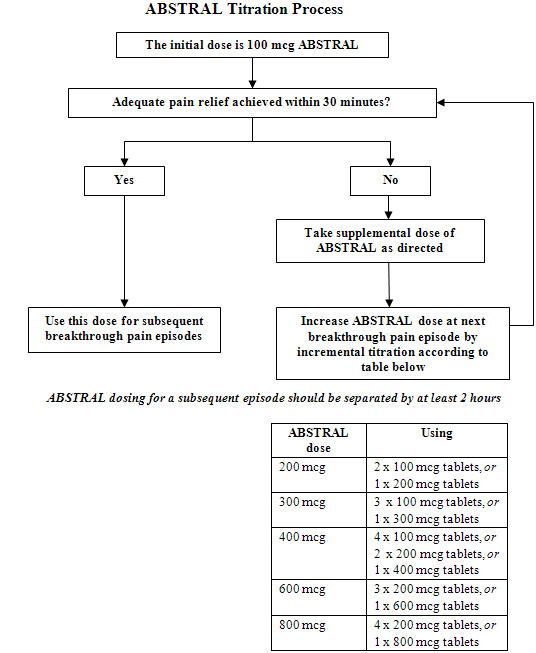
In order to minimize the risk of ABSTRAL-related adverse reactions and to identify the appropriate dose, it is imperative that patients be supervised closely by health professionals during the titration process.
2.2 Maintenance Therapy
Once an appropriate dose for pain management has been established, instruct patients to use only one ABSTRAL tablet of the appropriate strength per dose. Maintain patients on this dose.
If adequate analgesia is not obtained after use of ABSTRAL, the patient may use a second ABSTRAL dose (after 30 minutes) as directed by their health care provider. No more than two doses of ABSTRAL may be used to treat an episode of breakthrough pain.
Patients must wait at least 2 hours before treating another episode of breakthrough pain with ABSTRAL.
2.3 Dose Re-adjustment
If the response (analgesia or adverse reactions) to the titrated ABSTRAL dose markedly changes, an adjustment of dose may be necessary to ensure that an appropriate dose is maintained.
If more than four episodes of breakthrough pain are experienced per day, re-evaluate the dose of the long-acting opioid used for persistent underlying cancer pain. If the long-acting opioid or dose of long-acting opioid is changed, re-evaluate and re-titrate the ABSTRAL dose as necessary to ensure the patient is on an appropriate dose.
Limit the use of ABSTRAL to treat four or fewer episodes of breakthrough pain per day.
It is imperative that any dose re-titration is monitored carefully by a healthcare professional.
2.4 Administration of ABSTRAL
Place ABSTRAL tablets on the floor of the mouth directly under the tongue immediately after removal from the blister unit. Do not chew, suck, or swallow ABSTRAL tablets. Allow ABSTRAL tablets to completely dissolve in the sublingual cavity. Advise patients not to eat or drink anything until the tablet is completely dissolved.
In patients who have a dry mouth, water may be used to moisten the buccal mucosa before taking ABSTRAL.
2.5 Discontinuation of Therapy
For patients no longer requiring opioid therapy, consider discontinuing ABSTRAL along with a gradual downward titration of other opioids to minimize possible withdrawal effects.
In patients who continue to take their chronic opioid therapy for persistent pain but no longer require treatment for breakthrough pain, ABSTRAL therapy can usually be discontinued immediately.
3 DOSAGE FORMS AND STRENGTHS
ABSTRAL is formulated as a sublingual tablet and is available in six strengths, distinguishable by the shape of the tablet and by de-bossing on the tablet surface. All tablets are white:
100 microgram tablet is a round tablet marked with the number "1"
200 microgram tablet is an oval-shaped tablet marked with the number "2"
300 microgram tablet is a triangle-shaped tablet marked with the number "3"
400 microgram tablet is a diamond-shaped tablet marked with the number "4"
600 microgram tablet is a "D"-shaped tablet marked with the number "6"
800 microgram tablet is a capsule-shaped tablet marked with the number "8"
[see How Supplied/Storage and Handling (16.4)].
4 CONTRAINDICATIONS
ABSTRAL is contraindicated in the management of pain in opioid non-tolerant patients, because life-threatening hypoventilation could occur at any dose in patients not already taking around-the-clock opioid therapy. Patients considered opioid tolerant are those who are taking at least 60 mg oral morphine/day, or at least 25 mcg transdermal fentanyl/hour, 30 mg oral oxycodone/day, 8 mg oral hydromorphone/day, 25 mg oral oxymorphone/day, or an equianalgesic dose of another opioid for a week or longer.
ABSTRAL is contraindicated in the management of acute or postoperative pain, including headache/migraine, dental pain, or use in the emergency room.
ABSTRAL is contraindicated in patients with known intolerance or hypersensitivity to any of its components or the drug fentanyl. Anaphylaxis and hypersensitivity have been reported in association with the use of other oral transmucosal fentanyl products.
5 WARNINGS AND PRECAUTIONS
See Boxed Warning - WARNINGS: IMPORTANCE OF PROPER PATIENT SELECTION and POTENTIAL FOR ABUSE
5.1 ABSTRAL and Other Fentanyl Products
ABSTRAL is NOT equivalent to all other fentanyl products used to treat breakthrough pain on a mcg per mcg basis. There are differences in the pharmacokinetics of ABSTRAL relative to other fentanyl products which could potentially result in clinically important differences in the amount of fentanyl absorbed and could result in a fatal overdose.
When prescribing ABSTRAL to a patient, DO NOT convert from other fentanyl products. Directions for safely converting patients to ABSTRAL from other fentanyl products are not currently available. (Note: This includes oral, transdermal, or parenteral formulations of fentanyl). Therefore, for opioid-tolerant patients starting treatment for breakthrough pain, the initial dose of ABSTRAL is 100 mcg. Individually titrate each patient's dose to provide adequate analgesia while minimizing side effects. [See Dosage and Administration (2.1)]
When dispensing ABSTRAL to a patient, DO NOT substitute it for any other fentanyl product prescription.
5.2 Hypoventilation (Respiratory Depression)
Serious or fatal respiratory depression can occur even at recommended doses in patients using ABSTRAL. Respiratory depression is more likely to occur in patients with underlying respiratory disorders and elderly or debilitated patients, usually following large initial doses, including ABSTRAL, in opioid non-tolerant patients, or when opioids are given in conjunction with other drugs that depress respiration.
Respiratory depression from opioids is manifested by a reduced urge to breathe and a decreased rate of respiration, often associated with the "sighing" pattern of breathing (deep breaths separated by abnormally long pauses). Carbon dioxide retention from opioid-induced respiratory depression can exacerbate the sedating effects of opioids. This makes overdoses involving drugs with sedative properties and opioids especially dangerous.
5.3 Patient/Caregiver Instructions
Patients and their caregivers must be instructed that ABSTRAL contains a medicine in an amount which can be fatal to a child. Even though ABSTRAL is provided in child-resistant packaging, patients and their caregivers must be instructed to keep tablets out of the reach of children. [see How Supplied/Storage and Handling (16.2, 16.3), and Patient Counseling Information (17.1, 17.2)].
Taking ABSTRAL could be fatal in individuals for whom it is not prescribed and for those who are not opioid-tolerant.
Physicians and dispensing pharmacists must specifically question patients or caregivers about the presence of children in the home (on a full time or visiting basis) and counsel them regarding the dangers to children from inadvertent exposure.
5.4 Additive CNS Depressant Effects
The concomitant use of ABSTRAL with other CNS depressants, including other opioids, sedatives or hypnotics, general anesthetics, phenothiazines, tranquilizers, skeletal muscle relaxants, sedating antihistamines, and alcoholic beverages may produce increased depressant effects (e.g., hypoventilation, hypotension, and profound sedation). Concomitant use with potent inhibitors of cytochrome P450 3A4 isoform (e.g., erythromycin, ketoconazole, and certain protease inhibitors) may increase fentanyl levels, resulting in increased depressant effects [see Drug Interactions (7)].
Patients on concomitant CNS depressants must be monitored for a change in opioid effects and the dose of ABSTRAL adjusted, if warranted.
5.5 Effects on Ability to Drive and Use Machines
Opioid analgesics impair the mental and/or physical ability required for the performance of potentially dangerous tasks (e.g., driving a car or operating machinery). Warn patients taking ABSTRAL of these dangers and counsel them accordingly.
5.6 Chronic Pulmonary Disease
Because potent opioids can cause hypoventilation, titrate ABSTRAL with caution in patients with chronic obstructive pulmonary disease or pre-existing medical conditions predisposing them to hypoventilation. In such patients, even normal therapeutic doses of ABSTRAL may further decrease respiratory drive to the point of respiratory failure.
5.7 Head Injuries and Increased Intracranial Pressure
Administer ABSTRAL with extreme caution in patients who may be particularly susceptible to the intracranial effects of CO2 retention such as those with evidence of increased intracranial pressure or impaired consciousness. Opioids may obscure the clinical course of a patient with a head injury; use only if clinically warranted.
5.8 Cardiac Disease
Intravenous administration of fentanyl may produce bradycardia. Therefore, use ABSTRAL with caution in patients with bradyarrhythmias.
5.9 MAO Inhibitors
ABSTRAL is not recommended for use in patients who have received MAO inhibitors within the past 14 days. Severe and unpredictable potentiation by MAO inhibitors has been reported with opioid analgesics.
5.10 ABSTRAL REMS (Risk Evaluation and Mitigation Strategy) Program
Because of the risk for misuse, abuse, addiction, and overdose, ABSTRAL is available only through a restricted program called the ABSTRAL REMS. Healthcare professionals who prescribe to outpatients, outpatients, pharmacies and distributors must be enrolled in and comply with the ABSTRAL REMS program to prescribe, receive, dispense, and distribute ABSTRAL, respectively.
An overview of the requirements for prescribers, pharmacies, patients and distributors is included below.
- Healthcare professionals, who prescribe ABSTRAL for outpatient use, must review the prescriber educational materials, enroll in the Program, and commit to comply with the REMS requirements.
- To receive ABSTRAL, outpatients must understand the risks and benefits of the drug and sign a Patient-Prescriber Agreement with their healthcare provider; outpatients will be enrolled by the pharmacy at the time their first prescription is filled.
- Outpatient pharmacies, that dispense ABSTRAL for outpatient use, must enroll in the Program, train their pharmacy staff on the REMS requirements, and agree to comply with the REMS requirements.
- Inpatient pharmacies, that dispense ABSTRAL for inpatient use, must enroll in the Program, train their pharmacy staff on the REMS requirements, and agree to comply with the REMS requirements.
- Wholesalers and distributors, that distribute ABSTRAL must enroll in the Program, and commit to distributing only to authorized enrolled pharmacies.
To learn more about the specific REMS requirements and to enroll in the ABSTRAL REMS program call 1-888-227-8725 or visit www.abstralrems.com.
6 ADVERSE REACTIONS
6.1 Clinical Studies Experience
Because clinical trials are conducted under widely varying conditions, adverse event rates observed in the clinical trials of a drug cannot be directly compared to rates in the clinical trials of another drug and may not reflect the rates observed in practice.
The safety of ABSTRAL has been evaluated in 311 opioid-tolerant cancer patients with breakthrough pain. Two hundred and seventy (270) of these patients were treated in multiple-dose studies. The duration of therapy for patients in multiple-dose studies ranged from 1-405 days with an average duration of 131 days and with 44 patients treated for at least 12 months.
The most commonly observed adverse reactions with ABSTRAL include typical opioid adverse reactions, such as nausea, constipation, somnolence and headache. Expect opioid side effects and manage them accordingly.
The clinical trials of ABSTRAL were designed to evaluate safety and efficacy in treating patients with cancer and breakthrough pain; all patients were taking concomitant opioids, such as sustained-release morphine, sustained-release oxycodone or transdermal fentanyl, for their persistent pain.
The adverse reaction data presented in Table 1 reflect the actual percentage of patients experiencing reactions among patients who received ABSTRAL for breakthrough pain along with concomitant opioid use for persistent pain. There has been no attempt to correct for concomitant use of other opioids, duration of ABSTRAL therapy or cancer-related symptoms.
Table 1 lists adverse reactions with an overall frequency of 5% or greater within the total population that occurred during titration by maximum dose received. The ability to assign ABSTRAL a dose-response relationship to these adverse reactions is limited by the titration schemes used in these studies.
|
System Organ Class Preferred term N (%) |
100 mcg (n=22) |
200 mcg (n=23) |
300 mcg (n=55) |
400 mcg (n=38) |
600 mcg (n=52) |
800 mcg (n=80) |
Total (n=270) |
|---|---|---|---|---|---|---|---|
| Gastrointestinal disorders | |||||||
| Nausea | 1 (4.5) | 4 (17.4) | 5 (9.1) | 1 (2.6) | 2 (3.8) | 2 (2.5) | 15 (5.6) |
| Nervous system disorders | |||||||
| Somnolence | 0 | 2 (8.7) | 4 (7.3) | 2 (5.3) | 2 (3.8) | 2 (2.5) | 12 (4.4) |
| Dizziness | 0 | 0 | 3 (5.5) | 2 (5.3) | 0 | 1 (1.3) | 6 (2.2) |
| Headache | 0 | 0 | 0 | 1 (2.6) | 3 (5.8) | 1 (1.3) | 5 (1.9) |
Table 2 lists, by successful dose, adverse reactions with an overall frequency of ≥ 5% within the total population that occurred after a successful dose had been determined.
|
System Organ Class Preferred term N (%) |
100 mcg (n=7) |
200 mcg (n=12) |
300 mcg (n=22) |
400 mcg (n=20) |
600 mcg (n=35) |
800 mcg (n=72) |
Total (n=168) |
|---|---|---|---|---|---|---|---|
| Gastrointestinal disorders | |||||||
| Nausea | 1 (14.3) | 0 | 2 (9.1) | 0 | 1 (2.9) | 6 (8.3) | 10 (6.0) |
| Stomatitis | 0 | 1 (8.3) | 1 (4.5) | 0 | 0 | 1 (1.4) | 3 (1.8) |
| Constipation | 0 | 0 | 1 (4.5) | 2 (10.0) | 1 (2.9) | 4 (5.6) | 8 (4.8) |
| Dry mouth | 0 | 0 | 0 | 1 (5.0) | 2 (5.7) | 0 | 3 (1.8) |
| Nervous system disorders | |||||||
| Headache | 0 | 0 | 0 | 2 (10.0) | 1 (2.9) | 2 (2.8) | 5 (3.0) |
| Dysgeusia | 1 (14.3) | 0 | 0 | 0 | 0 | 1 (1.4) | 2 (1.2) |
| General disorders and administration site conditions | |||||||
| Fatigue | 0 | 0 | 0 | 1 (5.0) | 2 (5.7) | 0 | 3 (1.8) |
| Injury, poisoning and procedural complications | |||||||
| Accidental overdose | 1 (14.3) | 0 | 0 | 0 | 0 | 0 | 1 (0.6) |
| Respiratory, thoracic and mediastinal disorders | |||||||
| Dyspnoea | 0 | 1 (8.3) | 0 | 0 | 0 | 0 | 1 (0.6) |
| Skin and subcutaneous disorders | |||||||
| Hyperhidrosis | 1 (14.3) | 0 | 0 | 0 | 0 | 1 (1.4) | 2 (1.2) |
The frequencies listed below represent adverse reactions that occurred in ≥ 1% of patients from two clinical trials who experienced that reaction while receiving ABSTRAL. Reactions are classified by system organ class.
Adverse Reactions (≥ 1%)
Cardiac disorders: bradycardia, tachycardia.
Eye disorders: vision blurred.
Gastrointestinal disorders: abdominal pain, abdominal pain upper, aphthous stomatitis, constipation, dry mouth, dyspepsia, gingival ulceration, impaired gastric emptying, lip ulceration, mouth ulceration, nausea, stomach discomfort, stomatitis, tongue disorder, vomiting.
General disorders and administration site conditions: asthenia, drug withdrawal syndrome, fatigue, malaise.
Immune system disorders: drug hypersensitivity.
Injury, poisoning and procedural complications: accidental overdose.
Metabolism and nutrition disorders: anorexia, decreased appetite.
Nervous system disorders: amnesia, disturbance in attention, dizziness, dysgeusia, headache, hypoesthesia, lethargy, parosmia, somnolence, tremor.
Psychiatric disorders: affect lability, anxiety, confusional state, depression, disorientation, dysphoria, euphoric mood, insomnia, mental status changes, paranoia, sleep disorder.
Reproductive system and breast disorders: erectile dysfunction.
Respiratory, thoracic and mediastinal disorder: dyspnea, oropharyngeal pain, throat tightness.
Skin and subcutaneous disorders: hyperhidrosis, night sweats, pruritus, rash, skin lesion.
Vascular disorders: hypotension.
7 DRUG INTERACTIONS
Fentanyl is metabolized mainly via the human cytochrome P450 3A4 isoenzyme system (CYP3A4); therefore potential interactions may occur when ABSTRAL is given concurrently with agents that affect CYP3A4 activity.
The concomitant use of ABSTRAL with CYP3A4 inhibitors (e.g., indinavir, nelfinavir, ritonavir, clarithromycin, itraconazole, ketoconazole, nefazodone, saquinavir, telithromycin, aprepitant, diltiazem, erythromycin, fluconazole, grapefruit juice, verapamil, or cimetidine) may result in a potentially dangerous increase in fentanyl plasma concentrations, which could increase or prolong adverse drug effects and may cause potentially fatal respiratory depression. Patients receiving ABSTRAL who begin therapy with, or increase the dose of, CYP3A4 inhibitors need to be carefully monitored for signs of opioid toxicity over an extended period of time. Increase dosage conservatively.
The concomitant use of ABSTRAL with CYP3A4 inducers (e.g., barbiturates, carbamazepine, efavirenz, glucocorticoids, modafinil, nevirapine, oxcarbazepine, phenobarbital, phenytoin, pioglitazone, rifabutin, rifampin, St. John's wort, or troglitazone) may result in a decrease in fentanyl plasma concentrations, which could decrease the efficacy of ABSTRAL. Patients receiving ABSTRAL who stop therapy with, or decrease the dose of, CYP3A4 inducers need to be monitored for signs of increased ABSTRAL activity and the dose of ABSTRAL must be adjusted accordingly.
8 USE IN SPECIFIC POPULATIONS
8.1 Pregnancy - Category C
There are no adequate and well-controlled studies in pregnant women.
Use ABSTRAL during pregnancy only if the potential benefit justifies the potential risk to the fetus. No epidemiological studies of congenital anomalies in infants born to women treated with fentanyl during pregnancy have been reported.
Chronic maternal treatment with fentanyl during pregnancy has been associated with transient respiratory depression, behavioral changes, or seizures in newborn infants characteristic of neonatal abstinence syndrome.
In women treated acutely with intravenous or epidural fentanyl during labor, symptoms of neonatal respiratory or neurological depression were no more frequent than would be expected in infants of untreated mothers.
Transient neonatal muscular rigidity has been observed in infants whose mothers were treated with intravenous fentanyl.
Fentanyl is embryocidal in rats as evidenced by increased resorptions in pregnant rats at doses of 30 mcg/kg intravenously or 160 mcg/kg subcutaneously. Conversion to human equivalent doses indicates this is within the range of the human recommended dosing for ABSTRAL.
Fentanyl citrate was not teratogenic when administered to pregnant animals. Published studies demonstrated that administration of fentanyl (10, 100, or 500 mcg/kg/day) to pregnant rats from day 7 to 21, of their 21 day gestation, via implanted microosmotic minipumps, was not teratogenic (the high dose was approximately 6-times the human dose of 800 mcg per pain episode on a mcg/m2 basis). Intravenous administration of fentanyl (10 mcg/kg or 30 mcg/kg) to pregnant female rats from gestation day 6 to 18, was embryo- or feto-toxic, and caused a slightly increased mean delivery time in the 30 mcg/kg/day group, but was not teratogenic.
8.2 Labor and Delivery
Fentanyl readily crosses the placenta. Therefore do not use ABSTRAL during labor and delivery (including caesarean section) since it may cause respiratory depression in the fetus or in the newborn infant.
8.3 Nursing Mothers
Fentanyl is excreted in human milk; therefore, do not use ABSTRAL in women who are nursing because of the possibility of sedation and/or respiratory depression in their infants. Symptoms of opioid withdrawal may occur in infants at the cessation of nursing by women using ABSTRAL.
8.4 Pediatric Use
The safety and efficacy of ABSTRAL have not been established in patients below 18 years of age.
8.5 Geriatric Use
Of the 270 opioid tolerant patients with breakthrough cancer pain in the Phase 3 clinical studies of Abstral, 58 (21%) were 65 years of age and older. There was no difference in the median titrated dose in patients aged 65 years and older compared to those <65 years. No clinically meaningful difference was noted in the safety profile of the group 65 years of age and older as compared to younger patients in ABSTRAL clinical trials.
Elderly patients have been shown to be more sensitive to the effects of fentanyl when administered intravenously, compared with the younger adult population. Therefore, exercise caution when individually titrating ABSTRAL in elderly patients to provide adequate efficacy while minimizing risk.
8.6 Patients with Renal and Hepatic Impairment
Insufficient information exists to make recommendations regarding the use of ABSTRAL in patients with impaired renal or hepatic function. Fentanyl is metabolized primarily via human cytochrome P450 3A4 isoenzyme system and the inactive metabolite is mostly eliminated in urine. If the drug is used in these patients, use the drug with caution because of the reduced hepatic metabolism and renal excretion capacity in such patients.
8.7 Gender
Both male and female opioid-tolerant cancer patients were studied for the treatment of breakthrough cancer pain. No clinically relevant gender differences were noted either in efficacy or in observed adverse reactions.
9 DRUG ABUSE AND DEPENDENCE
9.1 Controlled Substance
ABSTRAL contains fentanyl, a Schedule II substance. Schedule II opioid substances such as fentanyl, hydromorphone, methadone, morphine, oxycodone, and oxymorphone have a high potential for abuse and addiction. ABSTRAL is also subject to misuse and criminal diversion.
9.2 Abuse and Addiction
Manage the handling of ABSTRAL to minimize the risk of misuse, including the restriction of access and accounting procedures as appropriate to the clinical setting and as required by law [see How Supplied/Storage and Handling (16.2, 16.3)].
Concerns about abuse, addiction, and diversion must not prevent the proper management of pain. However, all patients treated with opioids require careful monitoring for signs of abuse and addiction, because use of opioid analgesic products carries the risk of addiction even under appropriate medical use.
Addiction is a primary, chronic, neurobiologic disease, with genetic, psychosocial, and environmental factors influencing its development and manifestations. It is characterized by behaviors that include one or more of the following: impaired control over drug use, compulsive use, continued use despite harm, and craving. Drug addiction is a treatable disease, utilizing a multidisciplinary approach, but relapse is common. "Drug-seeking" behavior is very common in addicts and drug abusers.
Abuse and addiction are separate and distinct from physical dependence and tolerance. Be aware that addiction may not be accompanied by concurrent tolerance and symptoms of physical dependence in all addicts. In addition, abuse of opioids can occur in the absence of addiction and is characterized by misuse for non-medical purposes, often in combination with other psychoactive substances. Since ABSTRAL may be diverted for non-medical use, careful record keeping of prescribing information, including quantity, frequency, and renewal requests is strongly advised.
Proper patient assessment, safe prescribing practices, periodic re-evaluation of therapy, and proper dispensing and storage are appropriate measures that help to limit abuse of opioid drugs.
Contact your State Professional Licensing Board, or State Controlled Substances Authority for information on how to prevent and detect abuse or diversion of this product.
9.3 Dependence
Physical dependence is not ordinarily a concern in the treatment of patients with chronic cancer pain, and fear of tolerance and physical dependence must not deter using opiate doses that adequately relieve the pain.
Opioid analgesics may cause physical dependence that can result in withdrawal symptoms in patients who abruptly discontinue the drug. Withdrawal also may be precipitated through the administration of drugs with opioid antagonist activity (e.g., naloxone, nalmefene) or mixed agonist/antagonist analgesics (pentazocine, butorphanol, buprenorphine, nalbuphine).
Physical dependence usually does not occur to a clinically significant degree until after several weeks of continued opioid usage. Tolerance, in which increasingly larger doses are required in order to produce the same degree of analgesia, is initially manifested by a shortened duration of analgesic effect, and subsequently, by decreases in the intensity of analgesia.
10 OVERDOSAGE
10.1 Clinical Presentation
The manifestations of ABSTRAL overdosage are expected to be similar in nature to intravenous fentanyl and other opioids, and are an extension of its pharmacological actions with the most serious significant effect being hypoventilation [see Clinical Pharmacology (12.2)].
10.2 Immediate Management
Immediate management of opioid overdose includes removal of the ABSTRAL tablet, if still in the mouth, ensuring a patent airway, physical and verbal stimulation of the patient, and assessment of level of consciousness, ventilatory and circulatory status.
10.3 Treatment of Overdosage (Accidental Ingestion) in the Opioid NON-Tolerant Person
Provide ventilatory support, obtain intravenous access, and administer naloxone or other opioid antagonists as clinically indicated. The duration of respiratory depression following overdose may be longer than the effects of the opioid antagonist's action (e.g., the half-life of naloxone ranges from 30 to 81 minutes) and repeated administration may be necessary. Consult the package insert of the individual opioid antagonist for details.
10.4 Treatment of Overdosage in Opioid-Tolerant Patients
Provide ventilatory support and obtain intravenous access as clinically indicated. Judicious use of naloxone or another opioid antagonist may be warranted in some instances, but at the risk of precipitating an acute withdrawal syndrome.
10.5 General Considerations for Overdose
Management of severe ABSTRAL overdose includes: securing a patent airway, assisting or controlling ventilation and establishing intravenous access. In the presence of hypoventilation or apnea, assist or control ventilation, and administer oxygen as indicated.
Carefully observe and appropriately manage patients with overdose until their clinical condition is well controlled.
Although muscle rigidity interfering with respiration has not been seen following the use of ABSTRAL, this is possible with fentanyl and other opioids. If it occurs, manage it by using assisted or controlled ventilation, by an opioid antagonist, and as a final alternative, by a neuromuscular blocking agent.
11 DESCRIPTION
ABSTRAL (fentanyl) sublingual tablet is a solid formulation of fentanyl citrate, a potent opioid analgesic intended for oral sublingual administration. ABSTRAL is formulated as a white tablet available in six strengths, distinguishable by the shape of the tablet and by de-bossing on the tablet surface.
Active Ingredient: Fentanyl citrate, USP is N-(1-Phenethyl-4-piperidyl) propionanilide citrate (1:1). Fentanyl is a highly lipophilic compound (octanol-water partition coefficient at pH 7.4 is 816:1) that is freely soluble in organic solvents and sparingly soluble in water (1:40). The molecular weight of the free base is 336.5 (the citrate salt is 528.6). The pKa of the tertiary nitrogens are 7.3 and 8.4. The compound has the following structural formula:
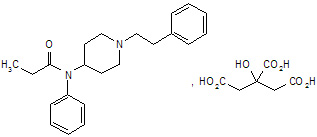
All tablet strengths are expressed as the amount of fentanyl free base, e.g., the 100 mcg strength tablet contains 100 mcg of fentanyl free base.
Inactive Ingredients: Croscarmellose sodium, magnesium stearate, mannitol, and silicified microcrystalline cellulose.
12 CLINICAL PHARMACOLOGY
12.1 Mechanism of Action
Fentanyl is a pure opioid agonist whose principal therapeutic action is analgesia. Other members of the class known as opioid agonists include substances such as morphine, oxycodone, hydromorphone, codeine, and hydrocodone.
12.2 Pharmacodynamics
Pharmacological effects of opioid agonists include anxiolysis, euphoria, feelings of relaxation, respiratory depression, constipation, miosis, cough suppression, and analgesia. Like all pure opioid agonist analgesics, with increasing doses there is increasing analgesia, unlike with mixed agonist/antagonists or non-opioid analgesics, where there is a limit to the analgesic effect with increasing doses. With pure opioid agonist analgesics, there is no defined maximum dose; the ceiling to analgesic effectiveness is imposed only by side effects, the more serious of which may include somnolence and respiratory depression.
Analgesia
In general, the effective concentration and the concentration at which toxicity occurs increase with increasing tolerance with any and all opioids. The rate of development of tolerance varies widely among individuals. As a result, individually titrate the dose of ABSTRAL to achieve the desired effect [see Dosage and Administration (2)].
Central Nervous System
The precise mechanism of the analgesic action is unknown although fentanyl is known to be a μ-opioid receptor agonist. Specific CNS opioid receptors for endogenous compounds with opioid-like activity have been identified throughout the brain and spinal cord and play a role in the analgesic effects of this drug.
Fentanyl produces respiratory depression by direct action on brain stem respiratory centers. The respiratory depression involves both a reduction in the responsiveness of the brain stem to increases in carbon dioxide and to electrical stimulation.
Fentanyl causes miosis even in total darkness. Pinpoint pupils are a sign of opioid overdose but are not pathognomonic (e.g., pontine lesions of hemorrhagic or ischemic origin may produce similar findings).
Gastrointestinal System
Fentanyl causes a reduction in motility associated with an increase in smooth muscle tone in the antrum of the stomach and in the duodenum. Digestion of food is delayed in the small intestine and propulsive contractions are decreased. Propulsive peristaltic waves in the colon are decreased, while tone may be increased to the point of spasm resulting in constipation. Other opioid induced-effects may include a reduction in gastric, biliary and pancreatic secretions, spasm of the sphincter of Oddi, and transient elevations in serum amylase.
Cardiovascular System
Fentanyl may produce release of histamine with or without associated peripheral vasodilation. Manifestations of histamine release and/or peripheral vasodilation may include pruritus, flushing, red eyes, sweating, and/or orthostatic hypotension.
Endocrine System
Opioid agonists have been shown to have a variety of effects on the secretion of hormones. Opioids inhibit the secretion of ACTH, cortisol, and luteinizing hormone (LH) in humans. They also stimulate prolactin secretion, growth hormone (GH) secretion, and pancreatic secretion of insulin and glucagon in humans and other species (e.g., rats and dogs). Thyroid stimulating hormone (TSH) has been shown to be both inhibited and stimulated by opioids.
Respiratory System
All opioid mu-receptor agonists, including fentanyl, produce dose-dependent respiratory depression. The risk of respiratory depression is less in patients receiving chronic opioid therapy who develop tolerance to these effects. Peak respiratory depressive effects may be seen as early as 15 to 30 minutes from the start of oral transmucosal fentanyl citrate administration and may persist for several hours.
Serious or fatal respiratory depression can occur even at recommended doses. Fentanyl depresses the cough reflex as a result of its CNS activity. Although not observed with oral transmucosal fentanyl products in clinical trials, fentanyl given rapidly by intravenous injection in large doses may cause rigidity in the muscles of respiration resulting in respiratory difficulties. Therefore, be aware of this potential complication [see Boxed Warning - Warnings: Importance Of Proper Patient Selection and Potential for Abuse,Contraindications (4), Warnings And Precautions (5.1), Adverse Reactions (6), and Overdosage (10)].
12.3 Pharmacokinetics
Absorption
Fentanyl is a highly lipophilic drug. Orally administered fentanyl undergoes pronounced hepatic and intestinal first pass effects. Absorption of fentanyl from ABSTRAL sublingual tablets is mainly through the oral mucosa.
The bioavailability of ABSTRAL sublingual tablets has been calculated to be 54%.
Dose proportionality across the 100 mcg to 800 mcg ABSTRAL dose range has been demonstrated (Table 3). Mean plasma fentanyl levels following single doses of ABSTRAL are shown in Figure 1. The median time to maximum plasma concentration (Tmax) across these four doses of ABSTRAL varied from 30 to 60 minutes (range of 15 - 240 minutes).
Figure 1: Mean (+/- SD) Plasma Fentanyl Concentration versus Time after Administration of Single Doses of 100 mcg, 200 mcg, 400 mcg and 800 mcg ABSTRAL to Healthy Subjects
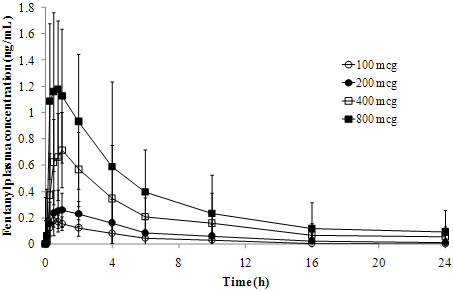
Pharmacokinetic parameters are presented in Table 3.
| Parameter | Unit | Abstral dose | |||
|---|---|---|---|---|---|
| 100 mcg | 200 mcg | 400 mcg | 800 mcg | ||
| a: median (range) | |||||
| Cmax | (ng/mL) | 0.187 (33) | 0.302 (31) | 0.765 (38) | 1.42 (33) |
| Tmaxa | (min) | 30 [19-120] | 52 [16-240] | 60 [30-120] | 30 [15-60] |
| AUC0-inf | (ng.h/mL) | 0.974 (34) | 1.92 (27) | 5.49 (35) | 8.95 (33) |
| T1/2 | (h) | 5.02 (51) | 6.67 (30) | 13.5 (37) | 10.1 (34) |
In another study, dose proportionality between 800 mcg and 1600 mcg in Cmax and AUC has also been demonstrated.
Pharmacokinetic studies have shown that multiple tablets are bioequivalent to single tablets of the equivalent dose.
Distribution
Fentanyl is highly lipophilic. Animal data showed that following absorption, fentanyl is rapidly distributed to the brain, heart, lungs, kidneys and spleen followed by a slower redistribution to muscles and fat. The plasma protein binding of fentanyl is 80-85%. The main binding protein is alpha-1-acid glycoprotein, but both albumin and lipoproteins contribute to some extent. The free fraction of fentanyl increases with acidosis. The mean volume of distribution at steady state (Vss) was 4 L/kg.
Metabolism
Fentanyl is metabolized in the liver and in the intestinal mucosa to norfentanyl by cytochrome P450 3A4 isoform. Norfentanyl was not found to be pharmacologically active in animal studies [see Drug Interactions (7)].
Elimination
Fentanyl is more than 90% eliminated by biotransformation to N-dealkylated and hydroxylated inactive metabolites. Less than 7% of the dose is excreted unchanged in the urine, and only about 1% is excreted unchanged in the feces. The metabolites are mainly excreted in the urine, while fecal excretion is less important. The total plasma clearance of fentanyl was 0.5 L/hr/kg (range 0.3 - 0.7 L/hr/kg).
13 NONCLINICAL TOXICOLOGY
13.1 Carcinogenesis, Mutagenesis, Impairment of Fertility
Long-term studies in animals have not been performed to evaluate the carcinogenic potential of fentanyl.
Fentanyl citrate was not mutagenic in the in vitro Ames reverse mutation assay in S. typhimurium or E. coli, or the mouse lymphoma mutagenesis assay, and was not clastogenic in the in vivo mouse micronucleus assay.
Fentanyl has been shown to impair fertility in rats at doses of 30 mcg/kg intravenously and 160 mcg/kg subcutaneously. Conversion to the human equivalent doses indicates that this is within the range of the human recommended dosing for ABSTRAL.
14 CLINICAL STUDIES
The efficacy of ABSTRAL was investigated in a clinical trial in opioid tolerant adult patients experiencing breakthrough cancer pain. Breakthrough cancer pain was defined as a transient flare of moderate-to-severe pain occurring in patients with cancer experiencing persistent cancer pain otherwise controlled with maintenance doses of opioid medications including at least 60 mg morphine/day, 50 mcg transdermal fentanyl/hour, or an equianalgesic dose of another opioid for 1 week or longer. All patients were on stable doses of either long-acting oral opioids or transdermal fentanyl for their persistent cancer pain.
A double-blind, placebo-controlled, crossover study was performed in patients with cancer to evaluate the effectiveness of ABSTRAL for the treatment of breakthrough cancer pain. Open-label titration identified a dose of ABSTRAL in which a patient obtained adequate analgesia with tolerable side effects, within the range of 100 mcg to 800 mcg. In the double-blind efficacy study, patients who identified a successful dose were randomized to a sequence of 10 treatments; seven with ABSTRAL and three with placebo.
Of the 131 patients who entered the titration phase of the study, 78 (60%) achieved a successful dose during the titration phase. Sixty-six patients entered the double-blind phase and 60 completed the study. The dose of ABSTRAL was determined by titration starting at 100 mcg. The final titrated dose of ABSTRAL for breakthrough cancer pain was not predicted from the daily maintenance dose of opioid used to manage the persistent cancer pain. In a second open-label safety study using an identical titration regimen, 96 of 139 patients (69%) who entered the study titrated to a dose in which the patient obtained adequate analgesia with tolerable side effects during the titration phase. Table 4 presents the final titrated dose for both the double-blind efficacy and open-label safety studies.
| ABSTRAL Dose |
N=174 n (%) |
|---|---|
| 100 mcg | 11 (6) |
| 200 mcg | 15 (9) |
| 300 mcg | 35 (20) |
| 400 mcg | 25 (14) |
| 600 mcg | 40 (23) |
| 800 mcg | 48 (28) |
The primary outcome measure, the mean sum of pain intensity difference at 30 minutes (SPID30) for ABSTRAL-treated episodes was statistically significantly higher than for placebo-treated episodes.
Figure 2: Mean Pain Intensity Difference (±SE) for ABSTRAL Compared to Placebo
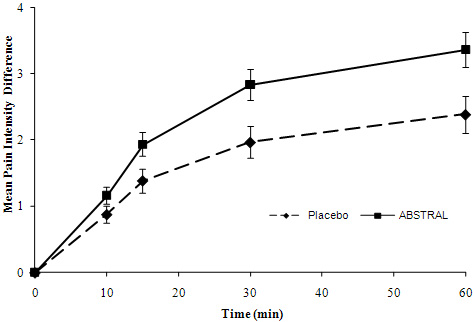
16 HOW SUPPLIED/STORAGE AND HANDLING
16.1 ABSTRAL REMS Program
ABSTRAL can only be dispensed from a pharmacy that is enrolled in the ABSTRAL REMS. For a list of pharmacies that are enrolled in the ABSTRAL REMS, and information on how a pharmacy can enroll, visit www.abstralrems.com or telephone 1-888-227-8725.
There are no refills for this Schedule II product. Dispensing ABSTRAL after the initial prescription requires a new valid prescription that has been verified in the ABSTRAL REMS program.
Ensure that an ABSTRAL Medication Guide is provided to the patient each time ABSTRAL is dispensed, as required by law.
16.2 Storage and Handling
ABSTRAL is supplied in individually sealed child-resistant blister packages contained in a cardboard outer carton, in pack sizes of 12 (100 mcg, 200 mcg, 300 mcg and 400 mcg strengths) or 32 (all strengths) tablets. The packaging is color-coded for each ABSTRAL tablet strength. The amount of fentanyl contained in ABSTRAL can be fatal to a child, individual for whom it is not prescribed or non-opioid tolerant adult. Patients and their caregivers must be instructed to keep ABSTRAL out of the reach of children [see Boxed Warning - Warnings: Potential For Abuse and Importance Of Proper Patient Selection and Warnings And Precautions (5), and Patient Counseling Information (17.1)].
Store at 20-25°C (68-77°F); excursions permitted between 15-30°C (59-86°F) [see USP Controlled Room Temperature]. Protect from moisture.
16.3 Disposal of ABSTRAL
Patients and their household members must be advised to dispose of any tablets remaining from a prescription as soon as they are no longer needed. Instructions are included in Patient Counseling Information (17.2) and in the Medication Guide.
To dispose of any unused ABSTRAL tablets, remove them from the blister cards and flush down the toilet. Do not dispose of the ABSTRAL blister cards or cartons down the toilet.
If additional assistance is required, call ProStrakan, Inc. at 1-888-227-8725.
16.4 How Supplied
ABSTRAL is supplied in six dosage strengths. Tablets are supplied in child-resistant, protective blister cards with peelable foil. Each blister card contains 4 tablets, in pack sizes of 12 (100 mcg, 200 mcg, 300 mcg and 400 mcg strengths) or 32 (all strengths) tablets.
Each tablet is white in color, with the strength distinguishable by the shape of the dosage unit and by de-bossing on the tablet surface:
|
Dosage Strength (fentanyl base) | Tablet Shape | Tablet Markings |
Carton/Blister Package Color | Pack size | NDC Number |
|---|---|---|---|---|---|
| 100 mcg | Round | "1" | Light blue |
12 32 |
42747-221-12 42747-221-32 |
| 200 mcg | Oval | "2" | Dark orange |
12 32 |
42747-222-12 42747-222-32 |
| 300 mcg | Triangle | "3" | Brown |
12 32 |
42747-223-12 42747-223-32 |
| 400 mcg | Diamond | "4" | Violet |
12 32 |
42747-224-12 42747-224-32 |
| 600 mcg | "D" | "6" | Turquoise | 32 | 42747-226-32 |
| 800 mcg | Capsule | "8" | Indigo | 32 | 42747-228-32 |
Note: Colors and shapes are a secondary aid in product identification. Please be sure to confirm the printed dosage before dispensing.
17 PATIENT COUNSELING INFORMATION
See the Medication Guide for specific patient instructions.
17.1 Patient/Caregiver Instructions
If prescribing to an outpatient, provide patients with a copy of the ABSTRAL Medication Guide and review it with them.
Allow patients the opportunity to ask questions and discuss any concerns regarding ABSTRAL or the ABSTRAL REMS program.
Instruct patients and their caregivers that ABSTRAL contains medicine in an amount that could be fatal in children, in individuals for whom ABSTRAL is not prescribed, and in those who are not opioid tolerant. Patients and their caregivers must be instructed to keep ABSTRAL, both used and unused dosage units, out of the reach of children. Patients and their caregivers must be instructed to dispose of any unneeded tablets remaining from a prescription as soon as possible [see How Supplied/Storage and Handling (16.2), and Warnings and Precautions (5.2).]
Instruct patients that ABSTRAL is only used for the management of breakthrough pain in cancer patients who are already receiving and who are tolerant to around-the-clock opioid therapy for their underlying persistent cancer pain.
Advise patients that ABSTRAL must be taken exactly as prescribed, with special regard for dosage and dose titration, and administration route. Advise patients not to switch from ABSTRAL to another fentanyl product without discussing with their prescriber.
Patients must sign the Patient-Prescriber Agreement Form to confirm that they understand the risks, appropriate use, and storage of ABSTRAL. Patients will be enrolled in the ABSTRAL REMS Program by the pharmacy at the time their first prescription is filled.
Advise patients that ABSTRAL is only available through pharmacies that are enrolled in the ABSTRAL REMS program. To help patients identify enrolled pharmacies, call 1-888-227-8725 or visit www.abstralrems.com.
Advise patients that they may be requested to participate in a survey to evaluate the effectiveness of the ABSTRAL REMS program.
17.2 Disposal of Unopened ABSTRAL Blister Packages When No Longer Needed
Advise patients and their household members to dispose of any unopened packs remaining from a prescription as soon as they are no longer needed.
Instruct patients that, to dispose of any unused ABSTRAL tablets, remove them from the blister cards and flush them down the toilet. Do not dispose of the ABSTRAL blister cards or cartons down the toilet.
Detailed instructions for the proper storage, administration, disposal, and important instructions for managing an overdose of ABSTRAL are provided in the ABSTRAL Medication Guide. Ensure patients read this information in its entirety and give them an opportunity to have their questions answered.
In the event that a caregiver requires additional assistance in disposing of excess units that remain in the home after the drug is no longer needed, instruct them to call the toll-free number for ProStrakan, Inc. 1-888-227-8725 or seek assistance from their local DEA office.
Medication Guide
ABSTRAL® (AB-stral) CII
(fentanyl)
Sublingual tablets
100 mcg, 200 mcg, 300 mcg, 400 mcg, 600 mcg, 800 mcg
| IMPORTANT:
Do not use ABSTRAL unless you are regularly using another opioid pain medicine around-the-clock for your cancer pain and your body is used to these medicines (this means that you are opioid tolerant). Keep ABSTRAL in a safe place away from children. Get emergency medical help right away if:
|
Read this Medication Guide completely before you start taking ABSTRAL, and each time you get a new prescription. There may be new information. This Medication Guide does not take the place of talking to your healthcare provider about your medical condition or your treatment. Be sure to share this important information with members of your household and other caregivers.
What is the most important information I should know about ABSTRAL?
ABSTRAL can cause life-threatening breathing problems which can lead to death.
- Do not take ABSTRAL if you are not opioid tolerant.
- If you stop taking your around-the-clock opioid pain medicine for your cancer pain, you must stop taking ABSTRAL. You may no longer be opioid tolerant. Talk to your healthcare provider about how to treat your pain.
-
Take ABSTRAL exactly as prescribed by your healthcare provider.
- You must not take more than 2 doses of ABSTRAL for each episode of breakthrough cancer pain.
- You must wait two hours before treating a new episode of breakthrough pain with ABSTRAL. See the Medication Guide section "How should I take ABSTRAL?" and the Patient Instructions for Use at the end of this Medication Guide for detailed information about how to take ABSTRAL the right way.
- Do not switch from ABSTRAL to other medicines that contain fentanyl without talking with your healthcare provider. The amount of fentanyl in a dose of ABSTRAL is not the same as the amount of fentanyl in other medicines that contain fentanyl. Your healthcare provider will prescribe a starting dose of ABSTRAL that may be different than other fentanyl containing medicines you may have been taking.
-
Do not take ABSTRAL for short-term pain that you would expect to go away in a few days, such as:
- pain after surgery
- headache or migraine
- dental pain
- Never give ABSTRAL to anyone else, even if they have the same symptoms you have. It may harm them or even cause death.
ABSTRAL is a federally controlled substance (CII) because it is a strong opioid (narcotic) pain medicine that can be misused by people who abuse prescription medicines or street drugs.
- Prevent theft, misuse or abuse. Keep ABSTRAL in a safe place to protect it from being stolen. ABSTRAL can be a target for people who abuse opioid (narcotic) medicines or street drugs.
- Selling or giving away this medicine is against the law.
ABSTRAL is available only through a program called the ABSTRAL REMS program. To receive ABSTRAL, you must:
- talk to your healthcare provider
- understand the benefits and risks of ABSTRAL
- agree to all of the instructions
- sign the Patient-Prescriber Agreement form
What is ABSTRAL?
- ABSTRAL is a prescription medicine that contains the medicine fentanyl.
- ABSTRAL is used to manage breakthrough pain in adults with cancer (18 years of age and older) who are already routinely taking other opioid pain medicines around-the-clock for cancer pain.
- ABSTRAL is started only after you have been taking other opioid pain medicines and your body has become used to them (you are opioid tolerant). Do not use ABSTRAL if you are not opioid tolerant.
- ABSTRAL is a small tablet that is placed on the floor of the mouth under your tongue (sublingual) and allowed to dissolve.
- You must stay under your healthcare provider's care while taking ABSTRAL.
- ABSTRAL is only:
- available through the ABSTRAL REMS program
- given to people who are opioid tolerant
It is not known if ABSTRAL is safe and effective in children under 18 years of age.
Who should not take ABSTRAL?
Do not take ABSTRAL:
- if you are not opioid tolerant. Opioid tolerant means that you are already taking other opioid pain medicines around-the-clock for your cancer pain, and your body is used to these medicines.
- for short-term pain that you would expect to go away in a few days, such as:
- pain after surgery
- headache or migraine
- dental pain
- if you are allergic to any of the ingredients in ABSTRAL. See the end of this Medication Guide for a complete list of other ingredients in ABSTRAL.
What should I tell my healthcare provider before taking ABSTRAL?
Before taking ABSTRAL, tell your healthcare provider if you:
- have trouble breathing or lung problems such as asthma, wheezing, or shortness of breath
- have or had a head injury or brain problem
- have liver or kidney problems
- have seizures
- have a slow heart rate or other heart problems
- have low blood pressure
- have mental health problems including major depression, schizophrenia or hallucinations (seeing or hearing things that are not there)
- have a past or present drinking problem (alcoholism), or a family history of drinking problems
- have a past or present drug abuse problem or addiction problem, or a family history of a drug abuse problem or addiction problem
- have any other medical conditions
- are pregnant or plan to become pregnant. ABSTRAL may cause serious harm to your unborn baby.
- are breastfeeding or plan to breastfeed. ABSTRAL can pass into your breast milk. It can cause serious harm to your baby. You should not use ABSTRAL while breastfeeding.
Tell your healthcare provider about all the medicines you take, including prescription and non-prescription medicines, vitamins, and herbal supplements. Some medicines may cause serious or life-threatening side effects when taken with ABSTRAL. Sometimes, the doses of certain medicines and ABSTRAL may need to be changed if used together.
- Do not take any medicine while using ABSTRAL until you have talked to your healthcare provider. Your healthcare provider will tell you if it is safe to take other medicines while you are using ABSTRAL.
- Be very careful about taking other medicines that may make you sleepy, such as other pain medicines, anti-depressants, sleeping pills, anti-anxiety medicines, antihistamines, or tranquilizers.
Know the medicines you take. Keep a list of them to show your healthcare provider and pharmacist when you get a new medicine.
How should I take ABSTRAL?
Before you can begin to take ABSTRAL:
- Your healthcare provider will explain the ABSTRAL REMS program to you.
- You will sign the ABSTRAL REMS program Patient-Prescriber Agreement form.
- ABSTRAL is only available at pharmacies that are part of the ABSTRAL REMS program. Your healthcare provider will let you know the pharmacy closest to your home where you can have your ABSTRAL prescription filled.
Taking ABSTRAL:
- Take ABSTRAL exactly as prescribed. Do not take ABSTRAL more often than prescribed.
- If you notice that your tablets are a different shape or color, be sure to check with your pharmacist to make sure you have the right strength of medicine.
- Do not suck, chew or swallow the tablet.
- See the detailed Patient Instructions for Use at the end of this Medication Guide for information about how to take ABSTRAL the right way.
- Your healthcare provider will change the dose until you and your healthcare provider find the right dose for you.
- You must not use more than 2 doses of ABSTRAL for each episode of breakthrough cancer pain:
- Take 1 dose for an episode of breakthrough cancer pain.
- If your breakthrough pain does not get better within 30 minutes after taking the first dose of ABSTRAL, you can take 1 more dose of ABSTRAL as instructed by your healthcare provider.
- If your breakthrough pain does not get better after the second dose of ABSTRAL, call your healthcare provider for instructions. Do not take another dose of ABSTRAL at this time.
- Wait at least 2 hours before treating a new episode of breakthrough cancer pain with ABSTRAL:
- If you only need to take 1 dose of ABSTRAL for an episode of breakthrough pain, you must wait 2 hours from the time of that dose to take a dose of ABSTRAL for a new episode of breakthrough pain
- If you need to take 2 doses of ABSTRAL for an episode of breakthrough pain, you must wait 2 hours after the second dose to take a dose of ABSTRAL for a new episode of breakthrough pain.
- It is important for you to keep taking your around-the-clock opioid pain medicine while taking ABSTRAL.
- Talk to your healthcare provider if your dose of ABSTRAL does not relieve your breakthrough cancer pain. Your healthcare provider will decide if your dose of ABSTRAL needs to be changed.
- Talk to your healthcare provider if you have more than 4 episodes of breakthrough cancer pain per day. The dose of your around-the-clock opioid pain medicine may need to be adjusted.
- If you take too much ABSTRAL or overdose, you or your caregiver should call for emergency medical help or have someone take you to the nearest hospital emergency room right away.
What should I avoid while taking ABSTRAL?
- Do not drive, operate heavy machinery, or do other dangerous activities until you know how ABSTRAL affects you. ABSTRAL can make you sleepy. Ask your healthcare provider when it is okay to do these activities.
- Do not drink alcohol while using ABSTRAL. It can increase your chance of getting dangerous side effects.
What are the possible side effects of ABSTRAL?
ABSTRAL can cause serious side effects, including:
-
Breathing problems that can become life-threatening. See "What is the most important information I should know about ABSTRAL?"
-
Call your healthcare provider or get emergency medical help right away if you:
- have trouble breathing
- have drowsiness with slowed breathing
- have shallow breathing (little chest movement with breathing)
- feel faint, very dizzy, confused, or have other unusual symptoms
-
Call your healthcare provider or get emergency medical help right away if you:
- Decreased blood pressure. This can make you feel dizzy or lightheaded if you get up too fast from sitting or lying down.
- Physical dependence. Do not stop taking ABSTRAL or any other opioid, without talking to your healthcare provider. You could become sick with uncomfortable withdrawal symptoms because your body has become used to these medicines. Physical dependency is not the same as drug addiction.
- A chance of abuse or addiction. This chance is higher if you are or have ever been addicted to or abused other medicines, street drugs, or alcohol, or if you have a history of mental health problems.
The most common side effects of ABSTRAL are:
- nausea
- sleepiness
- headache
Constipation (not often enough or hard bowel movements) is a very common side effect of pain medicines (opioids) including ABSTRAL and is unlikely to go away without treatment. Talk to your healthcare provider about dietary changes, and the use of laxatives (medicines to treat constipation) and stool softeners to prevent or treat constipation while taking ABSTRAL.
Tell your healthcare provider if you have any side effect that bothers you or that does not go away.
These are not all the possible side effects of ABSTRAL. For more information, ask your healthcare provider or pharmacist.
Call your doctor for medical advice about your side effects. You may report side effects to FDA at 1-800-FDA-1088.
How should I store ABSTRAL?
- Always keep ABSTRAL in a safe place away from children and from anyone for whom it has not been prescribed. Protect ABSTRAL from theft.
- Store ABSTRAL at room temperature, 59°F to 86°F (15°C to 30°C) until ready to use.
- Keep ABSTRAL in the original blister unit. Do not remove ABSTRAL tablets from their blister packaging for storage in a temporary container, such as a pillbox.
How should I dispose of unopened ABSTRAL tablets when they are no longer needed?
- Dispose of any unopened ABSTRAL units remaining from a prescription as soon as you no longer need them:
- remove the tablets from the blister cards and flush them down the toilet.
- Do not flush the ABSTRAL blister cards, units or cartons down the toilet.
- If you need help with disposal of ABSTRAL, call ProStrakan, Inc., at 1-888-227-8725 or call your local Drug Enforcement Agency (DEA) office.
General information about ABSTRAL
Medicines are sometimes prescribed for purposes other than those listed in a Medication Guide. Use ABSTRAL only for the purpose for which it was prescribed. Do not give ABSTRAL to other people, even if they have the same symptoms you have. ABSTRAL can harm other people and even cause death. Sharing ABSTRAL is against the law.
This Medication Guide summarizes the most important information about ABSTRAL. If you would like more information, talk with your healthcare provider or pharmacist. You can ask your pharmacist or healthcare provider for information about ABSTRAL that is written for healthcare professionals. You can also call the ABSTRAL REMS program at 1-888-227-8725 or visit www.abstralrems.com.
What are the ingredients in ABSTRAL?
Active Ingredient: fentanyl citrate
Inactive Ingredients: croscarmellose sodium, magnesium stearate, mannitol, and silicified microcrystalline cellulose.
Patient Instructions for Use
Before you take ABSTRAL, it is important that you read the Medication Guide and these Patient Instructions for Use. Be sure that you read, understand, and follow these Patient Instructions for Use so that you take ABSTRAL the right way. Ask your healthcare provider or pharmacist if you have questions about the right way to take ABSTRAL.
When you get an episode of breakthrough pain, take the dose prescribed by your healthcare provider as follows:
- If your mouth is dry, take a sip of water to moisten it. Spit out or swallow the water. Dry your hands if they are wet before you handle ABSTRAL tablets.
- ABSTRAL comes in a blister card with 4 blister units. Each blister unit contains an ABSTRAL tablet. It is important that the tablet stays sealed in the blister unit until you are ready to use it.
- When you are ready to take an ABSTRAL tablet, pull apart 1 of the blister units from the blister card by tearing along the dotted lines (perforations) until it is fully separated. (See Figures 1 and 2)
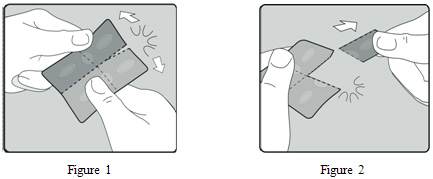
- When the blister unit is fully separated, peel back the foil starting at the unsealed area where indicated. Gently remove the tablet. Do not try to push ABSTRAL tablets through the foil. This will damage the tablet. (See Figures 3 and 4)
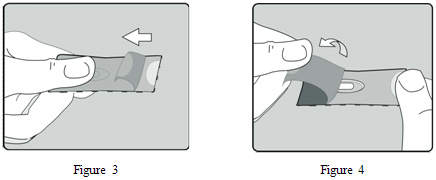
- As soon as you remove the ABSTRAL tablet from the blister unit:
- place it on the floor of your mouth, under your tongue, as far back as you can (See Figures 5, 6, and 7).

- If more than 1 tablet is required, spread them around the floor of your mouth under your tongue.
- Let the tablet dissolve completely.
ABSTRAL dissolves under your tongue and will be absorbed by your body to help provide relief for your breakthrough cancer pain. - Do not suck, chew or swallow the tablet.
- You should not drink or eat anything until the tablet has completely dissolved under your tongue and you can no longer feel it in your mouth.
- place it on the floor of your mouth, under your tongue, as far back as you can (See Figures 5, 6, and 7).
Manufactured by:
Novartis Consumer Health, Inc.,
Lincoln, NE 68517
Manufactured for:
ProStrakan Inc.,
Bedminster, NJ 07921
Issued: January 2011
This Medication Guide has been approved by the U.S. Food and Drug Administration.
Copyright © 2010, ProStrakan Inc. All rights reserved.
ABSTRAL and ProStrakan are trademarks owned by the ProStrakan group of companies.
PRINCIPAL DISPLAY PANEL - 100 mcg Tablet
NDC 42747-221-12
ABSTRAL® CII
(fentanyl) sublingual tablets
equivalent to 100 mcg fentanyl base
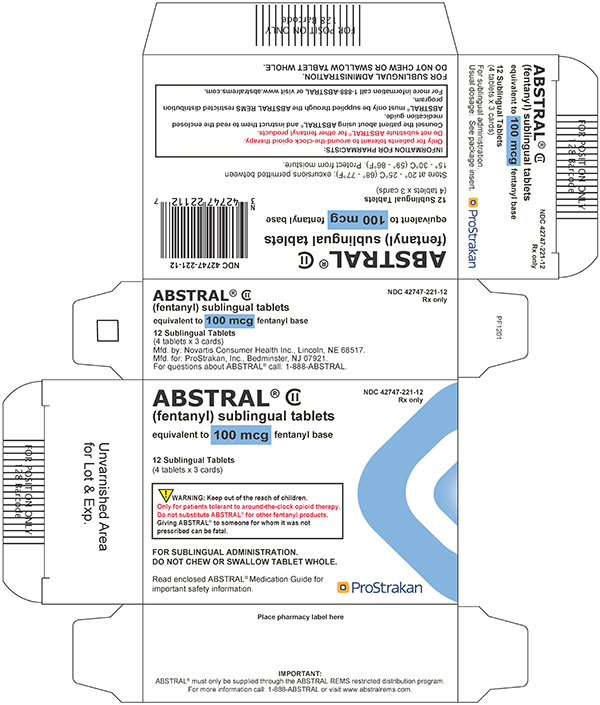
PRINCIPAL DISPLAY PANEL - 200 mcg Tablet
NDC 42747-222-12
ABSTRAL® CII
(fentanyl) sublingual tablets
equivalent to 200 mcg fentanyl base
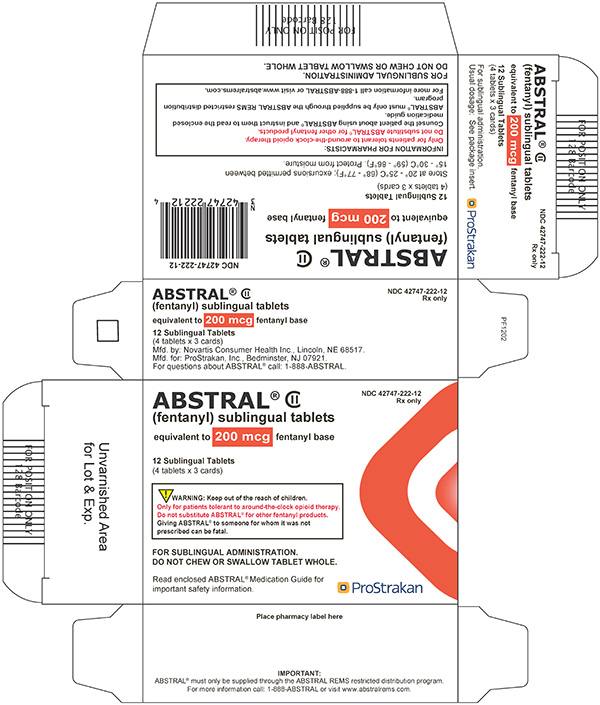
PRINCIPAL DISPLAY PANEL - 300 mcg Tablet
NDC 42747-223-12
ABSTRAL® CII
(fentanyl) sublingual tablets
equivalent to 300 mcg fentanyl base
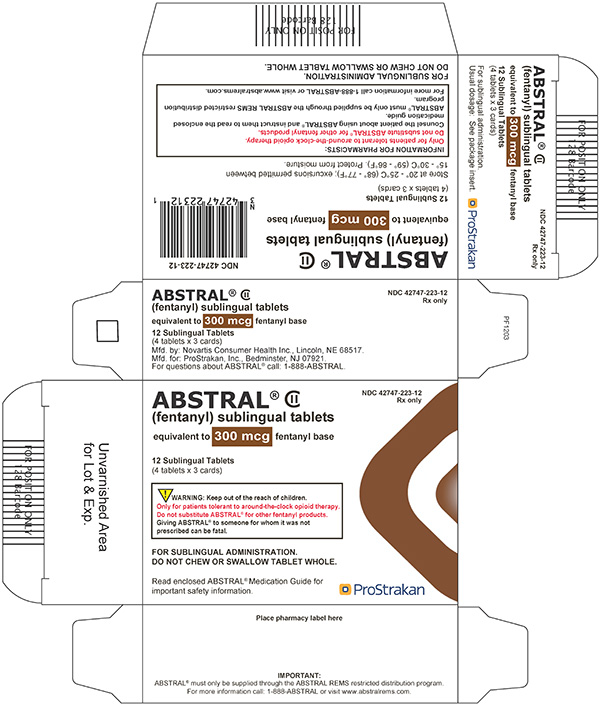
PRINCIPAL DISPLAY PANEL - 400 mcg Tablet
NDC 42747-224-12
ABSTRAL® CII
(fentanyl) sublingual tablets
equivalent to 400 mcg fentanyl base
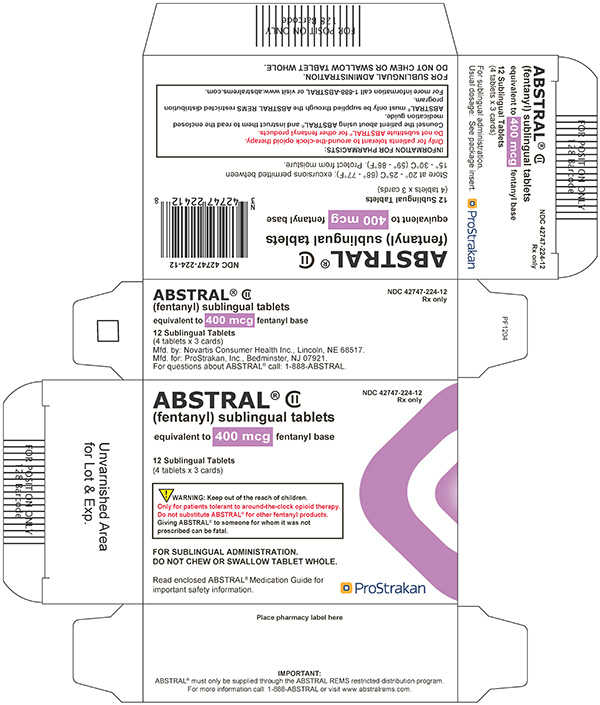
PRINCIPAL DISPLAY PANEL - 600 mcg Tablet
NDC 42747-226-32
ABSTRAL® CII
(fentanyl) sublingual tablets
equivalent to 600 mcg fentanyl base
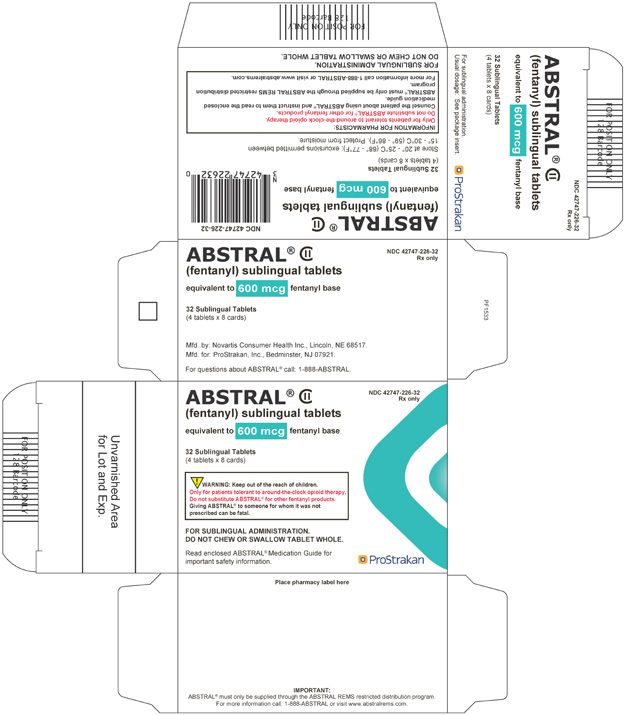
PRINCIPAL DISPLAY PANEL - 800 mcg Tablet
NDC 42747-228-32
ABSTRAL® CII
(fentanyl) sublingual tablets
equivalent to 800 mcg fentanyl base
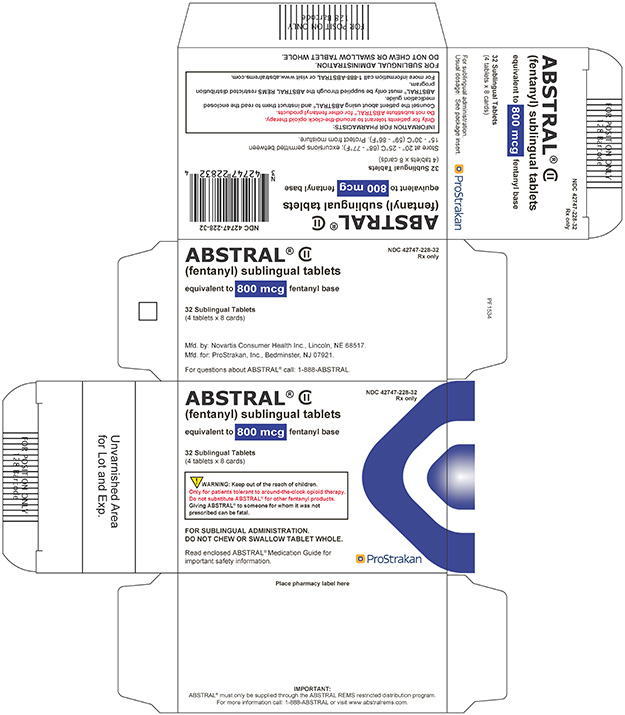
| ABSTRAL
fentanyl tablet |
||||||||||||||||||
|
||||||||||||||||||
|
||||||||||||||||||
|
||||||||||||||||||
|
||||||||||||||||||
|
||||||||||||||||||
| Marketing Information | |||
| Marketing Category | Application Number or Monograph Citation | Marketing Start Date | Marketing End Date |
| NDA | NDA022510 | 01/07/2011 | |
| ABSTRAL
fentanyl tablet |
||||||||||||||||||
|
||||||||||||||||||
|
||||||||||||||||||
|
||||||||||||||||||
|
||||||||||||||||||
|
||||||||||||||||||
| Marketing Information | |||
| Marketing Category | Application Number or Monograph Citation | Marketing Start Date | Marketing End Date |
| NDA | NDA022510 | 01/07/2011 | |
| ABSTRAL
fentanyl tablet |
||||||||||||||||||
|
||||||||||||||||||
|
||||||||||||||||||
|
||||||||||||||||||
|
||||||||||||||||||
|
||||||||||||||||||
| Marketing Information | |||
| Marketing Category | Application Number or Monograph Citation | Marketing Start Date | Marketing End Date |
| NDA | NDA022510 | 01/07/2011 | |
| ABSTRAL
fentanyl tablet |
||||||||||||||||||
|
||||||||||||||||||
|
||||||||||||||||||
|
||||||||||||||||||
|
||||||||||||||||||
|
||||||||||||||||||
| Marketing Information | |||
| Marketing Category | Application Number or Monograph Citation | Marketing Start Date | Marketing End Date |
| NDA | NDA022510 | 01/07/2011 | |
| ABSTRAL
fentanyl tablet |
||||||||||||||||||
|
||||||||||||||||||
|
||||||||||||||||||
|
||||||||||||||||||
|
||||||||||||||||||
|
||||||||||||||||||
| Marketing Information | |||
| Marketing Category | Application Number or Monograph Citation | Marketing Start Date | Marketing End Date |
| NDA | NDA022510 | 01/07/2011 | |
| ABSTRAL
fentanyl tablet |
||||||||||||||||||
|
||||||||||||||||||
|
||||||||||||||||||
|
||||||||||||||||||
|
||||||||||||||||||
|
||||||||||||||||||
| Marketing Information | |||
| Marketing Category | Application Number or Monograph Citation | Marketing Start Date | Marketing End Date |
| NDA | NDA022510 | 01/07/2011 | |
| Labeler - ProStrakan, Inc. (014778321) |
| Establishment | |||
| Name | Address | ID/FEI | Operations |
| Novartis Consumer Health, Inc. | 129836151 | manufacture | |